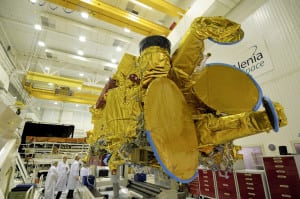Latest News
[Via Satellite 01-06-2015] Strong demand for satellite services will continue to drive the need for satellites and launchers, upping the competition for satellite and launch contracts over the next 10 years, according to new research from Frost & Sullivan. In the research firm’s new “Global Launch Systems and Satellites” report, the number of launches and satellites placed in orbit will increase between now and 2025.
“The major driver in the satellite industry is the insatiable need for bandwidth to allow for Internet communications, cellular voice and data, satellite content like [Direct-to-Home] DTH video, and in-flight entertainment, etc. It’s becoming more competitive because more companies see the demand increasing and want to take advantage of that demand,” Michael Blades, senior aerospace and defense industry analyst at Frost & Sullivan told Via Satellite.
But while satellites and launches are expected to increase in number, Frost & Sullivan predicts global space spending will stay relatively flat. New technologies, capabilities and entrants into the market are expected to increase competition, driving costs lower even as demand increases. For example, both manufacturers and launch providers have sought more dual launch opportunities in recent years. Arianespace conducted several dual launches in 2014, such as Astra 5B and Amazonas 4A in March, Measat 3b and Optus 10 in September, and DirecTV 14 and GSAT 16 in December aboard the Ariane 5. International Launch Services (ILS) partnered with ISS-Reshetnev in March 2014 to identify satellites that can launch in a stacked configuration on Proton, and in November Boeing mated two 702SP satellites for a SpaceX Falcon 9 dual launch.
3-D printing could also have a major impact on manufacturing techniques and launch systems. Companies such as Airbus, Lockheed Martin, Ruag and Aerojet Rocketdyne have been exploring the potential of additive manufacturing. Blades said he anticipates 3-D printing, though in limited use today will have a substantial effect on large satellites by reducing production times. Rockets however, could make even greater use.
“Both industries stand to benefit from additive manufacturing, but the launch vehicle makers will likely benefit more. This is because launch providers currently rely on expendable launchers and are more cost driven than satellite manufacturers. Satellites must still execute specific missions which will require complex sensors and systems. Lockheed Martin has predicted that an A2100 satellite could eventually have up to 50 percent of its parts created by additive manufacturing. A launch vehicle could potentially be entirely created through 3-D printing,” he explained.
Blades expects electric propulsion to become more accepted as the technology continues to improve. Compared to chemical propulsion, electric systems weigh less, letting operators choose between a lighter spacecraft or one with more components, but take longer to reach the right orbit and enter service. All-electric satellites can take months to reach their proper orbit after launch, whereas their chemically propelled counterparts take days. Blades said he believes the pros will ultimately outweigh the cons and demand will increase, but only steadily.
In the launch industry, Blades said dedicated small satellite launchers will gain popularity and become ever more capable as a function of Moore’s Law. This market has seen a steady stream of new entrants, such as Firefly Space Systems and Rocket Lab, as well as increasing focus from established players such as Arianespace with Vega and Lockheed Martin with Athena. But ultimately, the biggest stimulant to competitiveness in launching continues to be SpaceX.
“[SpaceX is] challenging the traditional roles of launch providers and providing efficient, low cost, reliable space launch capabilities,” said Blades. “They seem to be operating on a business model of volume rather than per launch profits, but they are causing global launch providers, like Arianespace, to find ways to cut costs so they don’t lose business.”
Get the latest Via Satellite news!
Subscribe Now